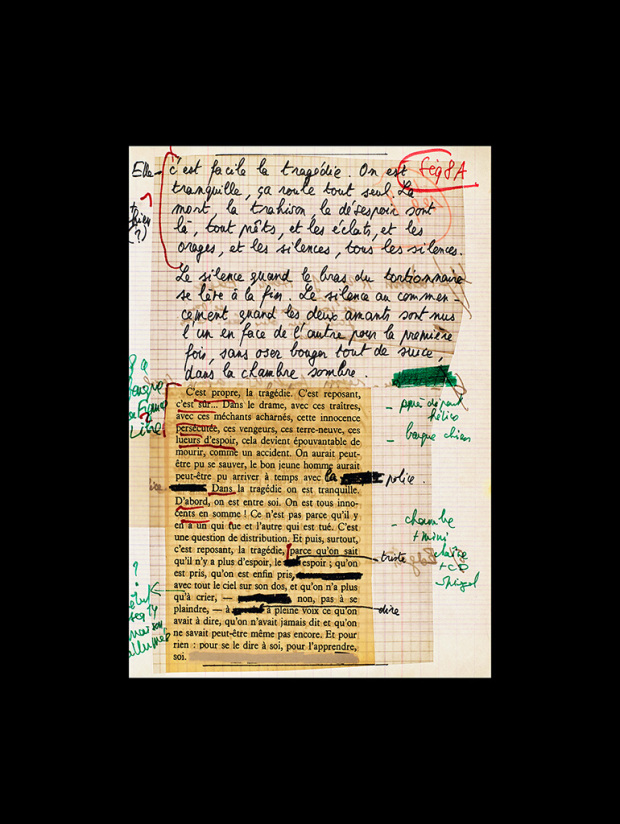An iconographic and text archive related to communication, technology and art.
☛ Paris Photo 2014: What We Leave Behind – Jean-Luc Godard Archives, “Study 7”, chromogenic color print by Stephan Crasneanscki. Images retrieved from L’Oeil de la Photographie.
The manuscript text in the photo is Godard’s reworking of an excerpt –glued bellow– from Jean Anouilh’s Antigone. Here, I reproduce a longer version of the excerpt, as it features references to cinema that must have been relevant to Godard:
The silence when the executioner lifts his arm at the end. The silence at the beginning, when two lovers are naked together for the first time, and at first, in the dark, don’t dare to move. The silence when the shouts of the crowd rise up around the victor — like a film with the sound-track stuck… all those open mouths with nothing coming out of them, all that clamour no more than an image. And the victor already vanquished, there in the midst of his silence.
Nice and neat, tragedy. Restful, too. In a drama, with its traitors, its desperate villains, its innocent victims, avengers, devoted followers and glimmers of hope, death becomes something terrible, a kind of accident. You might have arrived in time with the police. But tragedy’s so peaceful! For one thing, everybody’s on a par. All innocent! It doesn’t matter if one person kills and the other is killed — it’s just a matter of casting… (tr. Barbara Bray, A & C Black Publishers, 2000, pp. 25-26)
• • •
The image reproduced above is part of a photographic series by Stephan Crasneanscki depicting various items from Jean-Luc Godard’s audio-visual archives. The photos were exposed at the 2014 international art fair Paris Photo, in one of the stands curated by Ilan Engel Gallery. The 18th edition of the photo fair was held at the Grand Palais, in Paris, from November 13 to 16, 2014. Stephan Crasneanscki’s photographic work is represented by Ilan Engel Gallery, from which comes the following description:
Stephan Crasneanscki’s photographs are taken from a genuine yet largely forgotten audio-visual archive of Jean-Luc Godard, (re)discovered by chance somewhere in France. The images are mostly documentary in nature and feature vast piles of cardboard crates, packaging, reels and VHS tapes. They offer, directly or indirectly, an impression of the life of the film-maker and his works. (read more)
Bringing attention to the “sheer volume of content” of Godard´s archives, as well as its “apparently chaotic arrangement”, the same description ends by asking “What can we learn from these archives? Are they used? Can they even be used?” One way to start thinking about this interesting problem can be found in the work of Jacques Derrida, which Godard has used in his films. In Archive Fever. A Freudian Impression, the French philosopher insisted on the following point:
In an enigmatic sense, which will clarify itself perhaps (perhaps, because nothing should be sure here, for essential reasons), the question of the archive is not, we repeat, a question of the past. It is not the question of a concept dealing with the past that might already be at our disposal or not at our disposal, an archivable concept of the archive. It is a question of the future, the question of the future itself, the question of a response, a promise and of a responsibility for tomorrow. The archive: if we want to know what that will have meant, we will only know in times to come. Perhaps. Not tomorrow but in times to come, later on or perhaps never. A spectral messianicity is at work in the concept of the archive and ties it, like religion, like history, like science itself, to a very singular experience of the promise. (tr. Eric Prenowitz, Chicago: University of Chicago Press, 1996, p. 36).
For the issue at hand here, it would worth trying to further unfold what Derrida has in mind when he writes of what is “to come” (à venir): a messianicity without messiah that is intimately related with the way he practices deconstruction.
• • •
Stephan Crasneanscki is a multi-disciplinary artist based in New York. In the early 2000, he founded Soundwalk Collective (Facebook), an international collaborative group interested in the creation of sound performances and audiovisual installations. I first heard about its activity when I stumbled upon the radio essay they created in 2011 –in collaboration with Radio France Culture and Jean-Luc Nancy– about the encounter between Paul Celan and Martin Heidegger (previously). One can learn more about Stephan Crasneanscki at France-Amérique (see, in French: “Les vies téléchargeables de Stephan Crasneanscki” from 2009). Smart Magazine has a lengthier interview with the artist, in English: “Make Some Noise” by Katharina Kowalewski (Nov. 21, 2013).


- By Philippe Theophanidis
- on
- ― Published in Art, Communication, Movies, Technology
- Tagged: archive, deconstruction, Derrida, Godard, kairos, messianism

